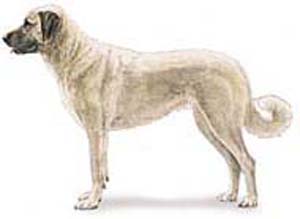Anatolian Shepherd Breed Standard
General Appearance
Large, rugged, powerful and impressive, possessing great endurance and agility. Developed through a set of very demanding circumstances for a purely utilitarian purpose; he is a working guard dog without equal, with a unique ability to protect livestock. General impression - Appears bold, but calm, unless challenged. He  possesses size, good bone, a well-muscled torso with a strong head. Reserve out of its territory is acceptable. Fluid movement and even temperament is desirable possesses size, good bone, a well-muscled torso with a strong head. Reserve out of its territory is acceptable. Fluid movement and even temperament is desirable
Size, Proportion, Substance
General balance is more important than absolute size. Dogs should be from 29 inches and weighing from 110 to 150 pounds proportionate to size and structure. Bitches should be from 27 inches, weighing from 80 to 120 pounds, proportionate to size and structure. Neither dog nor bitch appear fat. Both dog and bitch should be rectangular, in direct proportion to height. Measurements and weights apply at age 2 or older.
Head
Expression should be intelligent. Eyes are medium size, set apart, almond shaped and dark brown to light amber in color. Blue eyes or eyes of two different colors are a disqualification. Eye rims will be black or brown and without sag or looseness of haw. Incomplete pigment is a serious fault. Ears should be set on no higher than the plane of the head. V-shaped, rounded apex, measuring about four inches at the base to six inches in length. The tip should be just long enough to reach the outside corner of the eyelid. Ears dropped to sides. Erect ears are a disqualification. Skull is large but in proportion to the body. There is a slight centerline furrow, fore and aft, from apparent stop to moderate occiput. Broader in dogs than in bitches. Muzzle is blockier and stronger for the dog, but neither dog nor bitch would have a snipey head or muzzle. Nose and flews must be solid black or brown. Seasonal fading is not to be penalized. Incomplete pigment is a serious fault. Flews are normally dry but pronounced enough to contribute to "squaring" the overall muzzle appearance. Teeth and gums strong and healthy. Scissors bite preferred, level bite acceptable. Broken teeth are not to be faulted. Overshot, undershot or wry bite are disqualifications.
Neck, Topline, Body
Neck slightly arched, powerful, and muscular, moderate in length with more skin and fur than elsewhere on the body, forming a protective ruff. The dewlap should not be pendulous and excessive. Topline will appear level when gaiting. Back will be powerful, muscular, and level, with drop behind withers and gradual arch over loin, sloping slightly downward at the croup. Body well proportioned, functional, without exaggeration. Never fat or soft. Chest is deep (to the elbow) and well-sprung with a distinct tuck up at the loin. Tail should be long and reaching to the hocks. Set on rather high. When relaxed, it is carried low with the end curled upwards. When alert, the tail is carried high, making a "wheel." Both low and wheel carriage are acceptable, when gaiting. "Wheel" carriage preferred. The tail will not necessarily uncurl totally.
Forequarters
Shoulders should be muscular and well developed, blades long, broad and sloping. Elbows should be neither in nor out. Forelegs should be relatively long, well-boned and set straight with strong pasterns. The feet are strong and compact with well-arched toes, oval in shape. They should have stout nails with pads thick and tough. Dewclaws may be removed.
Hindquarters
Strong, with broad thighs and heavily muscled. Angulation at the stifle and hock are in proportion to the forequarters. As seen from behind, the legs are parallel. The feet are strong and compact with well-arched toes, oval in shape. Double dewclaws may exist. Dewclaws may be removed.
Coat
Short (one inch minimum, not tight) to Rough (approximately 4 inches in length) with neck hair slightly longer. Somewhat longer and thicker at the neck and mane. A thick undercoat is common to all. Feathering may occur on the ear fringes, legs, breeching, and tail.
Color
All color patterns and markings are equally acceptable
Gait
At the trot, the gait is powerful yet fluid. When viewed from the front or rear, the legs turn neither in nor out, nor do feet cross or interfere with each other. With increased speed, footfall converges toward the center line of gravity. When viewed from the side, the front legs should reach out smoothly with no obvious pounding. The withers and backline should stay nearly level with little rise or fall. The rear assembly should push out smoothly with hocks doing their share of the work and flexing well.
Temperament
Alert and intelligent, calm and observant. Instinctively protective, he is courageous and highly adaptable. He is very loyal and responsive. Highly territorial, he is a natural guard. Reserve around strangers and off its territory is acceptable. Responsiveness with animation is not characteristic of the breed. Overhandling would be discouraged.
Disqualifications
- Blue eyes or eyes of two different colors.
- Erect ears
- Overshot, undershot, or wry bite
|


 possesses size, good bone, a well-muscled torso with a strong head. Reserve out of its territory is acceptable. Fluid movement and even temperament is desirable
possesses size, good bone, a well-muscled torso with a strong head. Reserve out of its territory is acceptable. Fluid movement and even temperament is desirable